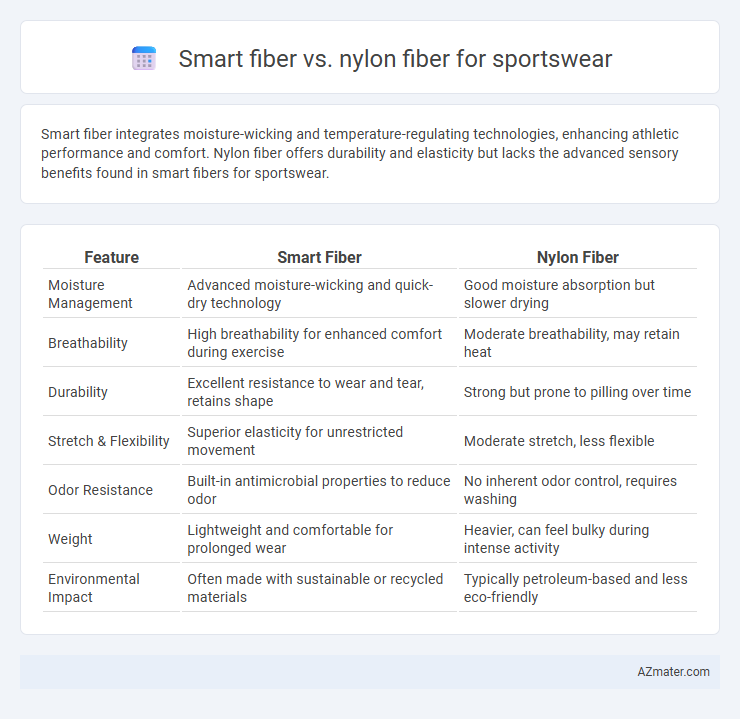Smart fiber integrates moisture-wicking and temperature-regulating technologies, enhancing athletic performance and comfort. Nylon fiber offers durability and elasticity but lacks the advanced sensory benefits found in smart fibers for sportswear.
Table of Comparison
| Feature | Smart Fiber | Nylon Fiber |
|---|---|---|
| Moisture Management | Advanced moisture-wicking and quick-dry technology | Good moisture absorption but slower drying |
| Breathability | High breathability for enhanced comfort during exercise | Moderate breathability, may retain heat |
| Durability | Excellent resistance to wear and tear, retains shape | Strong but prone to pilling over time |
| Stretch & Flexibility | Superior elasticity for unrestricted movement | Moderate stretch, less flexible |
| Odor Resistance | Built-in antimicrobial properties to reduce odor | No inherent odor control, requires washing |
| Weight | Lightweight and comfortable for prolonged wear | Heavier, can feel bulky during intense activity |
| Environmental Impact | Often made with sustainable or recycled materials | Typically petroleum-based and less eco-friendly |
Introduction: The Evolution of Sportswear Materials
Smart fibers in sportswear utilize advanced technologies like moisture-wicking, temperature regulation, and antimicrobial properties to enhance athletic performance and comfort. Nylon fibers, known for their durability, elasticity, and lightweight nature, have long been favored for sports apparel but lack the adaptive features of smart textiles. The evolution from traditional nylon to smart fibers marks a significant advancement in sportswear, optimizing functionality and wearer experience through engineered fabric innovations.
Defining Smart Fiber and Nylon Fiber
Smart fiber in sportswear refers to advanced textile materials engineered with responsive properties such as moisture-wicking, temperature regulation, and enhanced durability, often incorporating microcapsules or conductive fibers for improved athletic performance. Nylon fiber, a synthetic polymer known for its high tensile strength, elasticity, and resistance to abrasion, is widely used in sportswear for its lightweight feel and quick-drying capabilities. Both fibers serve distinct athletic needs, with smart fibers offering adaptive functionalities and nylon providing foundational durability and comfort.
Moisture Management: Which Fiber Performs Better?
Smart fibers in sportswear outperform nylon fibers in moisture management by actively enhancing breathability and accelerating sweat evaporation. These fibers incorporate advanced textile technology that wicks moisture away from the skin more efficiently than traditional nylon fibers, resulting in better thermal regulation and comfort during intense physical activities. Nylon fibers, while durable and lightweight, generally retain more moisture, making smart fibers the superior choice for optimal moisture control in athletic wear.
Durability and Wear Resistance Comparison
Smart fiber outperforms nylon fiber in sportswear durability due to its advanced molecular structure that enhances resistance to abrasion and stretching. Nylon fiber, while strong, tends to degrade faster under repetitive stress and exposure to moisture, limiting its longevity in high-intensity activities. Incorporating smart fiber in sportswear ensures prolonged wear resistance, maintaining fabric integrity and performance over time.
Comfort and Flexibility in Athletic Activities
Smart fiber offers enhanced moisture-wicking and temperature regulation, providing superior comfort during intense athletic activities compared to traditional nylon fiber. Its advanced elasticity allows for greater flexibility and freedom of movement, adapting dynamically to the athlete's motions. Nylon fiber, while durable and lightweight, lacks the specialized breathability and adaptive stretch that makes smart fiber ideal for high-performance sportswear.
Breathability and Temperature Regulation
Smart fiber outperforms nylon fiber in breathability due to its advanced moisture-wicking properties and enhanced micro-ventilation structure, which help maintain optimal body temperature during intense physical activities. Nylon fiber, while durable and lightweight, tends to retain more heat and moisture, potentially causing discomfort and reduced performance. The superior temperature regulation of smart fibers makes them ideal for high-performance sportswear, promoting better thermal management and overall athlete comfort.
Odor Control Capabilities
Smart fiber in sportswear incorporates antimicrobial properties that actively inhibit bacterial growth, significantly reducing odor formation during intense physical activities. Nylon fiber, while durable and moisture-wicking, lacks inherent antimicrobial treatment, making it less effective at controlling persistent odors over extended wear. Advanced Smart fibers engineered with silver ions or biocides provide superior, long-lasting odor control compared to traditional Nylon fabrics.
Environmental Impact and Sustainability
Smart fibers, designed with biodegradable and eco-friendly materials, significantly reduce microplastic pollution and decompose faster than traditional nylon fibers, which are petroleum-based and contribute to long-term environmental waste. Nylon production involves high energy consumption and releases nitrous oxide, a potent greenhouse gas, whereas smart fibers are often engineered from renewable or recycled sources, lowering carbon footprints. Choosing smart fibers for sportswear supports sustainability by minimizing environmental damage and promoting circular economy practices in textile manufacturing.
Cost Efficiency and Market Availability
Smart fiber offers enhanced durability and moisture-wicking properties, making it a cost-efficient choice for high-performance sportswear despite a higher initial price. Nylon fiber is widely available and typically more affordable upfront but may require more frequent replacement due to lower resistance to wear and sweat. Market availability favors nylon, given its established supply chains, whereas smart fiber is gaining traction in premium sportswear segments.
Choosing the Right Fiber for Your Sportswear Needs
Smart fibers offer advanced moisture-wicking, temperature regulation, and antimicrobial properties ideal for high-performance sportswear, enhancing comfort and durability during intense activities. Nylon fibers provide excellent strength, abrasion resistance, and quick-drying capabilities, making them suitable for various athletic apparel focused on durability and lightweight wear. Selecting the right fiber depends on activity type, climate, and desired performance features, with smart fibers excelling in adaptive comfort and nylons favoring resilience and versatility.

Infographic: Smart fiber vs Nylon fiber for Sportswear
 azmater.com
azmater.com